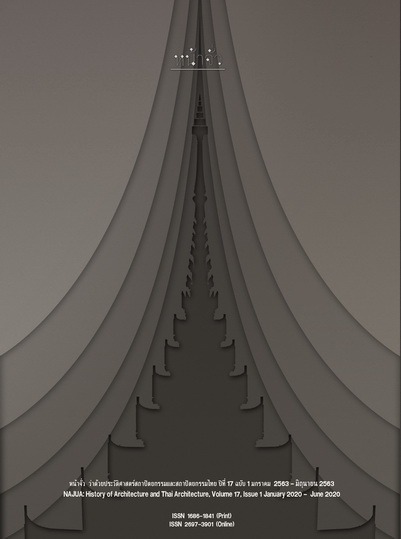VERNADOC and Vernacular Architecture Documentation of Thais
Main Article Content
Abstract
VERNADOC DOCUMENTATION is a surveying method originated from Finland, later become known in Thailand through the Survey of Architecture Heritage Project under the name of VERNADOC camp. This study aims to understand basic concepts, principles, roles, as well as the status of VERNADOC in the context of documenting Thai vernacular architecture. The study found that essential principles of VERNADOC lay in on-site measurement and making exquisite drawings. Characteristics of VERNADOC DOCUMENTATION are that, first of all, instead of text and specifications, texture and shadow are fundamental features employed to give life to the drawings, making them appealing to the onlookers. Secondly, VERNADOC premises voluntary participation in setting up documentation camp, which once done, a collection of drawings is exhibited at that community immediately afterwards, thus allowing the locals to appreciate their community from a different perspective.
Such efficiency and benefits have inspired the Finnish architect Markku Mattila to adopt the method, which belongs to more than 100 years old tradition of Finish architects, to organise the first international vernacular architecture documentation camp in 2005. It is expected that measured drawings and other procedures such as interviewing and participatory observation would give a strong impetus to buildings' owners and local peoples to appreciate the value of their heritage, willing to preserving them as a result.
In Thailand, the first VERNADOC camp held in 2007 by ICOMOS Thailand. Since then, further camps have been supported by the Association of Siamese Architects under Royal Patronage and various architectural institutions to train volunteers both Thai and foreigners about VERNADOC. Documenting heritage buildings and exhibiting the result to the public have made VERNADOC known. Nowadays, a total of 73 camps have been organised in different regions of Thailand. Many of the former participants in VERNADOC Thailand & network have developed themselves to become trainers and have led 13 campsites abroad from a total of 120 camps organised in 22 countries around the world. Of all the camps organised by VERNADOC Thailand & network, more than 80 percent carried out a record of little-known vernacular architecture which have never been documented. Thus, apart from offering benefits to participants, documentations through VERNADIC help building up a database for vernacular architecture in Thailand as well as network countries into the same system. These accurate and reliable will further benefit future study and conservation as well as giving inspiration to future generations.
Downloads
Article Details

This work is licensed under a Creative Commons Attribution-NonCommercial-NoDerivatives 4.0 International License.
References
Blomstedt, Yrjö and Victor Sucksdorff. Karjalaisia Rakennuksia ja Koristemuotoja [Karelian buildings and decoration]. Helsinki: n.p., 1904.
Dioptra. Accessed November 27, 2016. Available from https://en.wikipedia. org/wiki/ Dioptra
Freese, Simo. Hokos, Warma, Vol.1 Taloja ja kyliä saaristosta, Karjalasta ja Inkeristä gårdar och byar från skärgården, Karelen och Ingermanland. Helsinki: Tekknillisen korkeakoulun arckkitehtiosasto arkkitehtuurin historia, 1997.
Groma (surveying). Aaccessed November 27, 2016. Available https://en.wikipedia. org/wiki/Groma_surveying
Hirn, Marta, ed. Kuvia katoavasta Suomesta [Pictures of vanishing Finland]. Helsinki: n.p., 1970.
Johnson, Anthony. Solving Stonehenge: The new key to an ancient enigma. Thames & Hudson, 2008.
Koponen, Anu Kaisa. “Roman Architects in Athens (200-10 BC).” In ITALIAN VERNADOC 2015, 14-15. Edited by Markku Mattila. Helsinki: CIAV of ICOMOS Finland, 2015.
Mattila, Markku. “First 10 Vernadoc years.” In Italian Vernadoc 2015-Amandola: Studying Italia and its architecture the first 10 Vernadoc-years, 105-111. Edited by Markku Mattila. Helsinki: CIAV od ICOMOS Finland, 2015.
Mattila, Markku. VERNADOC 2005. Helsinki: The Vernacular Committee of ICOMOS Finland, 2006.
Mattila, Markku. “Vernadoc-Documenting Vernacular Architecture.” In Vernacular architecture reflections: Challenges and future, 6-8. Edited by Marwa Dabaieh and Valeria Prieto (Lund: Media-Tryck, 2016.
Mattila, Markku, ed. CIAV Vernadoc 2010 Keski-Skandinavian Suomalaiset: Östmarkin Kirkko, Savutuvat. Helsinki: Suomen ICOMOS, kansanrakentamisen komitea, 2011.
Mattila, Mattila ja Svartström, Niina (Toim.). Pre VERNADOC 1996 Inkeroiset Soikkolanniemi. Helsinki: CIAV Suomen ICOMOS, 2017.
Oliver, Paul, ed. Encyclopedia of vernacular architecture of the world, Volume 1: Theories and Principles. Cambridge: Cambridge University Press, 1998.
Somchart Chungsiriarak. Sathāpattayakam Bǣp Tawantok nai Sayām Samai Ratchakān thī sī - Phō̜.Sō̜. 2480. [Western architecture in Siam during King Rama IV-A.D. 1937]. Bangkok: Faculty of Architecture, Silpakorn University, 2010.
Sudjit Sananwai. “sathān sưksā sathāpattaya-kam nai prathēt Thai kap kānʻanurak sathāpattayakam phư̄n thin yāng yangyư̄n: kō̜ranī sưksā Mahāwit- thayālai Rangsit. [Architectural Academic Institutions in Thailand and Sustainable vernacular architecture conservation: Case study–Rangsit University].” ICOMOS Thailand Proceeding 2004, 2005.
Sudjit Sananwai. Vernadoc, Volume 1: Thailand. Bangkok: The Association of Siamese Architects under Royal Patronage, 2013.
Surveying. Accessed November 27, 2016. Available from https://en.wikipedia. org/wiki/Surveying


